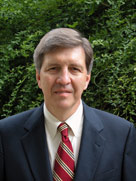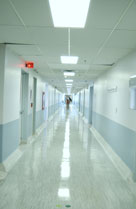Home
Previous Issue
Next Issue
College Home
College Calendar
Aggie Daily
- - - - - - - - - - - - - -
Media contact:
Phillip Rollfing
979.458.0442
email |
| |
| |
Ulrich Hospitals

Hospital buildings influence
patient outcomes,
Ulrich says
| |
|
Architects in the 21st century have a once-in-a-lifetime opportunity
to transform American hospitals into patient-friendly healing
environments, says Roger Ulrich, professor of architecture at
Texas A&M University.
"Peer-reviewed research shows that hospitals are risky and
stressful places, made more so by inappropriate traditional designs," Ulrich
adds. "Research demonstrates the effects of the designed physical
environment on medical outcomes, influencing the stress, pain,
infection and satisfaction experienced by patients and even playing
a part in whether a patient lives or dies. Hospitals built today
may remain in place for generations, directly and intimately touching
the lives of most Americans."
Ulrich was among several researchers featured at the College of
Architecture's seventh annual faculty research symposium, "Research
on the Built and Virtual Environments: Global Symposia Presentations
2005." He cites his own research and that of others to show
that modern hospital designs should incorporate single-bed rooms
with adequate lighting, proper ventilation and air filtration systems
and convenient fixtures that encourage frequent hand-washing, all
measures that reduce patient stress and the possibility of hospital-acquired
infection.
The presentations, begun six years ago, showcase the college faculty's
excellence in teaching and their research, which is "expanding
the envelope beyond the norm," says Dean J. Thomas Regan. "This
conference helps our faculty understand what others in the college
are doing, enabling better collaboration, and helps our graduate
students decide which faculty members they want to work with."
In addition to research on health facility design (Kirk Hamilton,
Mardelle Shepley, Susan Rodiek) and construction, presentations
at the conference ranged from converting existing structures into "surge" hospitals
to cope with disasters (Sherry Bame, George Mann) to development
of interpretations for the World War II battlefield site at Pointe
du Hoc, France (Richard Burt) to surviving a major earthquake (John
Nichols) to enhancing the realism of virtual simulations of water
bubbles (Donald House) to technical matters such as contingent
payment clauses in construction contracts (Joe Horlen) and movement
of coefficients of compressed earth masonry units (Charles Graham)
and methods of teaching architecture, among others.
Phillip R. Berke, who received his doctorate in architecture from
Texas A&M and is now at the University of North Carolina, Chapel
Hill, delivered the keynote address, which examined the effectiveness
of emerging alternative to traditional city planning patterns.
Mel Lees, professor at the University of Salford's School of Construction
and Property Management in Manchester, England, gave an invited
presentation on opportunities for collaboration between his institution
and faculty at Texas A&M. Fifty-three faculty research projects
were presented at the conference.
A report on health-facility design cited by Ulrich may be accessed
at:
http://www.healthdesign.org.
| |

Roger Ulrich

A stark hospital hallway
|
|
| |
|
|


